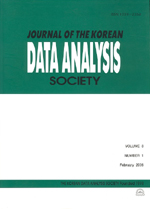재무분석가 이익예측오차의 상관관계 패턴에 대한 연구
Correlation Pattern of Analysts’ Forecast Errors
- 한국자료분석학회
- Journal of The Korean Data Analysis Society (JKDAS)
- Vol.12 No.3
-
2010.061691 - 1701 (11 pages)
- 11

이익발표 후 잔류현상에 대한 선행연구들은 자본시장참가자들이 단순히 계절별랜덤워크 모형에 근거하여 분기이익을 예측한다고 보고하였다. 분기이익의 시계열속성을 충분히 이해하지 못하고 단순히 계절별랜덤워크에 근거하여 이익을 예측함으로써 자본시장이 인지하는 비기대이익은 일정한 패턴으로 상관관계를 가지는 것으로 나타났다. 자본시장의 정보중개인으로서 재무분석가들이 제공하는 이익예측치는 자본시장참가자들의 이익예측치를 나타내는 것으로 여겨졌다. 이에 본 연구는 재무분석가들의 이익예측오차가 어떠한 상관관계를 가지는가를 분석함으로써 재무분석가들이 이익예측 시에 계절별랜덤워크에 의존하는 정도를 이해하고자 한다. 분석결과 재무분석가들의 이익예측오차는 미래 분기의 이익예측오차와 양의 상관관계를 가지고 있으나 자본시장참가자들의 비기대이익이 가지는 패턴의 상관관계를 가지고 있지는 않는 것으로 나타났다. 기업규모와 재무분석가의 수로 대리되는 기업정보환경에 따른 이익예측오차의 상관관계를 조사한 결과 기업정보환경이 풍부할 수록 재무분석가의 이익예측오차가 가지는 상관관계의 정도는 약화되는 것으로 나타났다.
The purpose of this study is to examine the correlation of analysts forecast errors across adjacent quarters. Prior studies documented that abnormal returns are predictable based on previously announced earnings, which is called post-earnings-announcement drift (PEAD). The most plausible explanation for the PEAD has been the market’s underreaction to the persistence of earnings forecast errors. Bernard and Thomas(1990) explained that market investors’ reliance on the seasonal random walk, and thus the ignorance of the persistence of forecast error is related to the PEAD. Since analysts forecasts represent the market investors’ earnings expectation, there is a possibility that analysts also rely on seasonal random walk in the process of making earnings forecasts. Empirical results show that analysts forecast errors are correlated across the adjacent quarters, indicating that analysts also underreact to the persistence of the forecast errors. However, the correlation pattern does not indicate that analysts appear to rely on seasonal random walk. Also further analysis show that the magnitude of the correlation decreases in relation to firm size and the number of analysts.
1. 서론
2. 연구배경
3. 표본산정 및 변수측정
4. 실증분석결과
5. 결론
참고문헌
(0)
(0)